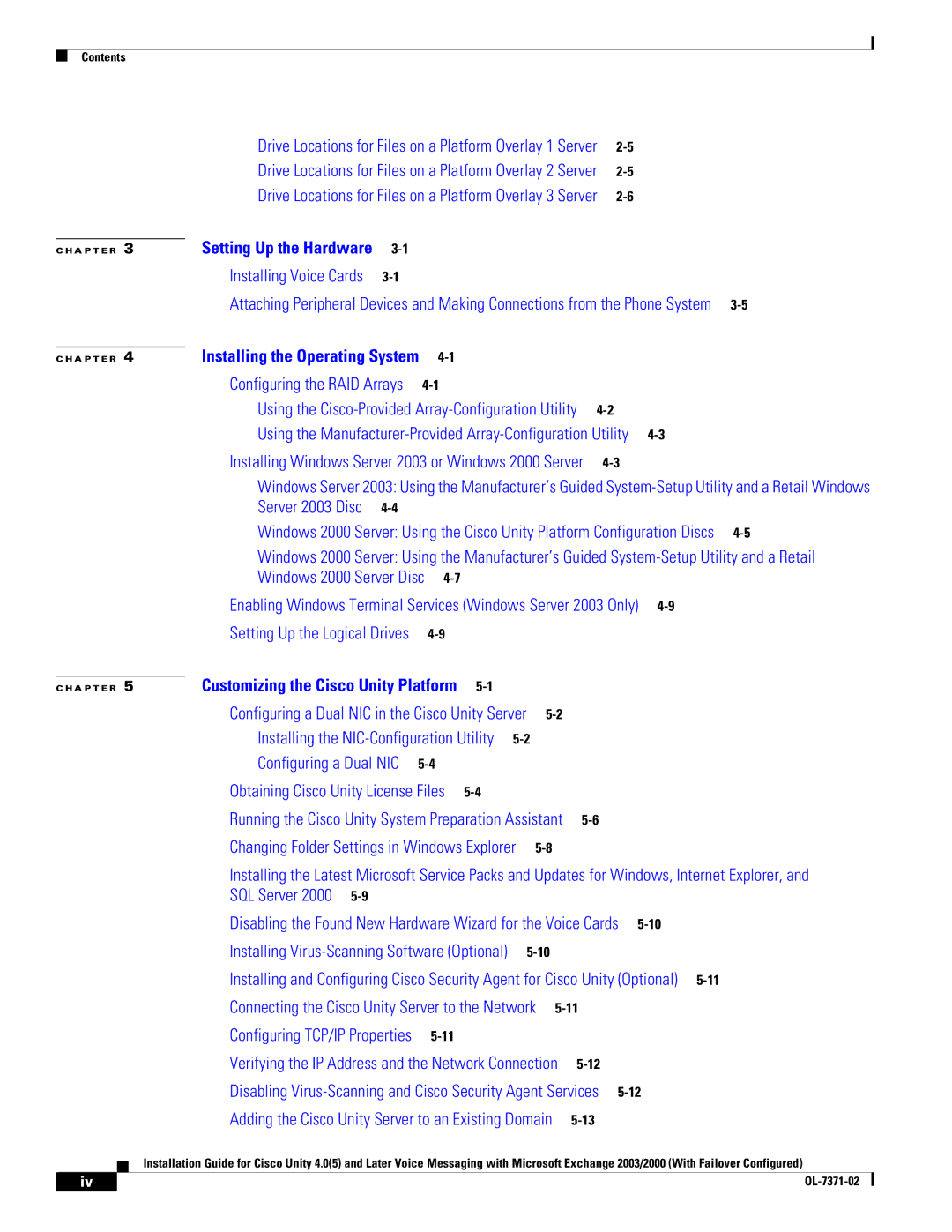
Contents
Drive Locations for Files on a Platform Overlay 1 Server | |
Drive Locations for Files on a Platform Overlay 2 Server | |
Drive Locations for Files on a Platform Overlay 3 Server |
C H A P T E R | 3 | Setting Up the Hardware |
|
|
|
|
|
|
| |
|
| Installing Voice Cards |
|
|
|
|
|
|
| |
|
| Attaching Peripheral Devices and Making Connections from the Phone System | ||||||||
|
| Installing the Operating System |
|
|
|
|
|
|
| |
C H A P T E R | 4 |
|
|
|
|
|
| |||
|
| Configuring the RAID Arrays |
|
|
|
|
|
| ||
|
| Using the |
|
| ||||||
|
| Using the |
| |||||||
|
| Installing Windows Server 2003 or Windows 2000 Server |
|
| ||||||
|
| Windows Server 2003: Using the Manufacturer’s Guided | ||||||||
|
| Server 2003 Disc |
|
|
|
|
|
|
| |
|
| Windows 2000 Server: Using the Cisco Unity Platform Configuration Discs | ||||||||
|
| Windows 2000 Server: Using the Manufacturer’s Guided | ||||||||
|
| Windows 2000 Server Disc |
|
|
|
|
|
| ||
|
| Enabling Windows Terminal Services (Windows Server 2003 Only) |
| |||||||
|
| Setting Up the Logical Drives |
|
|
|
|
|
| ||
|
| Customizing the Cisco Unity Platform |
|
|
|
|
|
| ||
C H A P T E R | 5 |
|
|
|
|
| ||||
|
| Configuring a Dual NIC in the Cisco Unity Server |
|
|
|
| ||||
|
| Installing the |
|
|
|
| ||||
|
| Configuring a Dual NIC |
|
|
|
|
|
| ||
|
| Obtaining Cisco Unity License Files |
|
|
|
|
| |||
|
| Running the Cisco Unity System Preparation Assistant |
|
|
| |||||
|
| Changing Folder Settings in Windows Explorer |
|
|
|
| ||||
|
| Installing the Latest Microsoft Service Packs and Updates for Windows, Internet Explorer, and | ||||||||
|
| SQL Server 2000 |
|
|
|
|
|
|
|
|
|
| Disabling the Found New Hardware Wizard for the Voice Cards |
| |||||||
|
| Installing |
|
|
|
| ||||
|
| Installing and Configuring Cisco Security Agent for Cisco Unity (Optional) |
| |||||||
|
| Connecting the Cisco Unity Server to the Network |
|
|
| |||||
|
| Configuring TCP/IP Properties |
|
|
|
|
|
| ||
|
| Verifying the IP Address and the Network Connection |
|
|
| |||||
|
| Disabling |
|
| ||||||
|
| Adding the Cisco Unity Server to an Existing Domain |
|
|
| |||||
Installation Guide for Cisco Unity 4.0(5) and Later Voice Messaging with Microsoft Exchange 2003/2000 (With Failover Configured)
| iv |
| |
|
|
